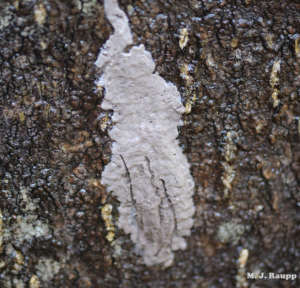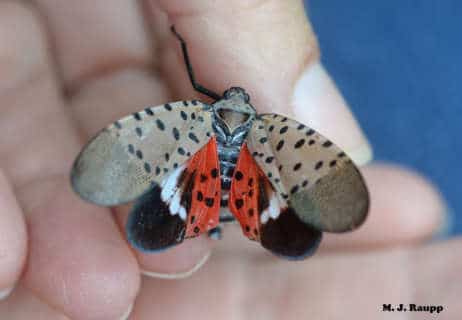Another invasive insect arrives in the region
The spotted lanternfly — an invasive insect from Asia — had been, so far, only seen in several counties outside of Philadelphia, but, this year, it has been sighted in parts of Virginia.
Here’s what to know about the spotted lanternfly:
- The egg masses of this pest generally look like mud, which becomes crusty-looking with age. These masses are laid on trees, camping equipment, firewood and, more insidiously, cars, trucks and railroad vehicles that can transport the pest vast distances.
- The juvenile (“nymph” or “instar”) forms of the insect are a wild black with white stars; they are plant-hoppers, so don’t look for any wings yet. The last instar stage before adulthood mimics an old joke: “What’s black and white and red all over?” Now, they got wings.
- The adult is so colorful (mostly red, gray, black and clearly designed by a science-fiction artist) that it looks like a villain on the old “Batman” 1966 TV show.
- Don’t be fooled: “Lanternflies” are plant hoppers, not true flying insects. You may see them with their (mostly useless) wings spread, but more likely they will assume the posture of a cricket or grasshopper.
If you see any of these life cycles, please report the location immediately.
From Pa. to Va. with love (actually, stone)

The invasion began several years ago in an area of Pennsylvania where several counties meet up: Berks, Bucks, Montgomery and Lehigh. A new invasive insect called the spotted lanternfly had been sighted.
A notorious pest of grapevines and other fruits in its native Asia, its favorite food source was — and still is — the ironically named “Tree of Heaven,” itself an Asian invasive. The insanely colorful adults have been spotted by the hundreds on these trash trees, depositing enormous amounts of their sweet “honeydew” — a much too-nice name for bug poop — that attracts large numbers of ants and wasps, especially dangerous yellow jackets.
And now that they’ve hitchhiked to Virginia (reportedly on a truckload of Pennsylvania stone), it is imperative that you report any sightings of any life cycle of this destructive insect.
Lanternfly life cycle
This January, the mudlike egg masses of the spotted lanternfly were spotted in Virginia for the first time in the Front Royal area.
In April, they spotted the black and white nymphs, which, despite the “fly” in their name, are long-distance hoppers.
By July, the almost too-colorful adults were spotted, laying large numbers of eggs, especially on the also invasive “Tree of Heaven.” Grapevines are next.
As of early October, some adults are still being observed, although the biggest threat is the mudlike egg cases, which are often laid on the sides of vehicles (especially the often already-muddy wheel wells), allowing the invaders to travel long distances while dormant.
If you’re in the target area, have seen the adults or have recently traveled to southeast Pennsylvania, get thee to a carwash!
Observe, report, destroy
The spotted lanternfly — a notorious pest of grapevines and other fruit crops — has been confirmed to have spread to the Winchester/Front Royal area of Virginia.
It is imperative for everyone in the region to learn how to identify the different life stages of the pest, to report any sightings and to destroy the mudlike egg cases of the pest before they can hatch out next spring.
Penn State has the most and best informational articles and photos of this creature’s many guises, but Virginia is catching up fast.
To familiarize yourself with the invasive spotted lanterfly, read up on these websites (your grapes and fruit trees are depending on you):
- Pennsylvania Department of Agriculture on the spotted lanterfly in the state;
- Penn State Extension; and
- Virginia Cooperative Extension.
A final word: Please do not use insecticides or sticky traps until you check out next week’s “Garden Plot,” where I will attack this pest with effective common-sense solutions.
Please report sightings of the Spotted Lanternfly in Virginia, Maryland and D.C. here. The site is technically for Virginia, but D.C. or Maryland findings will be sent to the appropriate state or federal agency for their area.
In other news this week: Pretty orchids!
Whew — we need this relief!
Ready for a dazzling orchid extravaganza? The National Capital Orchid Society’s annual show and sale returns to spoil us with one of the best free events in the area. As it has for the past several years, the Orchid Extravaganza will be held at Behnke’s Nursery on Baltimore Avenue in Beltsville, Maryland, running Friday through Monday (which is Columbus Day).
Now in its 71st year, you’ll see thousands of orchids on display and for sale. “Orchid doctors” will be on hand to diagnose what ails your particular plant, and educational talks are scheduled every day over this long weekend — and it’s all free.
Mike McGrath was editor-in-chief of ORGANIC GARDENING magazine from 1990 through 1997. He has been the host of the nationally syndicated public radio show “You Bet Your Garden” since 1998 and WTOP Garden Editor since 1999. Send him your garden or pest control questions at MikeMcG@PTD.net.





